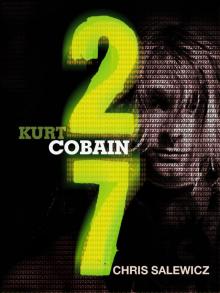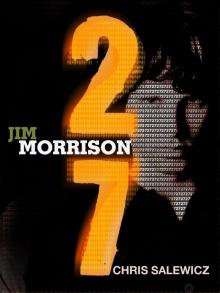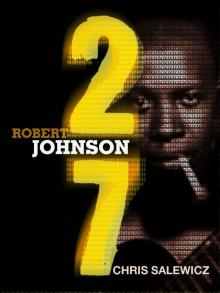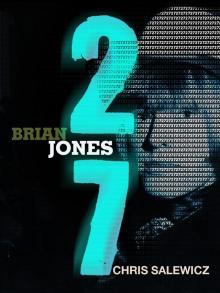- Home
- Salewicz, Chris
27: Brian Jones Page 6
27: Brian Jones Read online
Page 6
*
On 13 September, Keith, Brian, Charlie Watts and Bill Wyman arrived in New York to shoot the sleeve shot for Their Satanic Majesties Request. At immigration Keith was taken to one side and questioned for thirty minutes over the drugs trial. Then he was ordered to report to immigration offices in Manhattan the next day. As Brian’s case had not yet come to trial in Britain, he sailed through immigration. Mick Jagger, sporting the newly de rigueur mutton chop sideburns, arrived in New York on a later flight and went through an almost identical experience to Keith. While the Stones were in New York there was a climactic management meeting with Allen Klein. On 20 September, there was an announcement that Andrew Loog Oldham was being replaced as Stones’ manager by Klein.
Brian, however, continued to disintegrate. He had spent ten days at the Priory in London on his return from Monterey. London was awash with rumours that he was about to leave the group. All the same, whatever state he was in he was working at Olympic Studios in west London with the Stones. After sessions on 5, 6 and 7 September, he had flown to Marbella in the south of Spain with Suki Poitier, the Portuguese-born former girlfriend of Tara Browne who had been with the Guinness heir in his fatal car smash the previous December. He returned to the Spanish resort with Suki, a doppelganger for Anita Pallenberg, on 20 October for several days. Brian needed to rest up: his court case was set for the end of the month.
On 30 October 1967 he appeared in court. He was shaky and wan despite his faint tan, a consequence as much as anything of his previous night’s excesses with Jimi Hendrix at a Moody Blues concert. His voice trembled as he pleaded guilty to possession of cannabis and allowing it to be smoked at his flat. After a short trial, Brian was given a nine-month prison term, an extraordinarily heavy sentence. He was taken off to Wormwood Scrubs, where Keith had been briefly incarcerated. As soon as he arrived at the ‘Scrubs’, the ‘screws’ threatened ‘Mr Shampoo’ with the haircut they said he was about to have. A demonstration in the Kings Road by about fifty hippies led to the arrest of eight people, one of whom was Chris Jagger, Mick’s brother. After an application for an appeal was successful the next morning, Brian Jones was released from prison on bail of £750.
Allen Klein felt obliged to issue a statement: ‘There is absolutely no question of bringing in a replacement for Brian.’
Brian’s appeal was set for 12 December and Mick attended the court hearing. A trio of psychiatrists described Brian as ‘an extremely frightened young man’. The sentence was set aside, and Brian was given three years’ probation and fined the maximum of £1,000. Two days later, still in a state of apparent ongoing nervous breakdown, Brian collapsed at his new Belgravia apartment and was taken to the nearby St George’s Hospital at Hyde Park Corner. He discharged himself the same night.
Now the undisputed leader of the Stones, Mick Jagger called a press conference. ‘There’s a tour coming up,’ he began, although this was news to everyone around the group. ‘There are obvious difficulties, one of them is with Brian, who can’t leave the country.’ Although there were rumours that Jimmy Page would leave the Yardbirds to replace Brian in the Rolling Stones, the group insisted they were without foundation and that they could continue as a four-piece until Brian had sorted out his problems.
At least Brian’s appeal served as lateral publicity for the Stones’ new album, which was released in the United Kingdom on 8 December. In the United States, where it had been released twelve days previously, Satanic Majesties had already sold over $2 million worth of copies. In Britain, however, the long-player was widely dismissed – especially by John Lennon, who considered it yet another Stones’ rip-off of the Beatles (of Sgt Pepper in this particular case).
Their tails between their legs from the critical trouncing they had received at home, Mick, Keith and Brian quit the country for Christmas. With Stash de Rola along for the ride, Brian headed for Ceylon with another new girlfriend – none other than Linda Keith. It was as though he was bound in an inescapable psychic prison with Keith Richards and Anita Pallenberg.
*
During March 1968 the Stones were again at Olympic Studios, recording what would become Beggars Banquet. The subject of film was high on the group’s agenda. The television director Michael Lindsay-Hogg, a close friend of Mick, was hired to make a promotional clip for a new single, ‘Jumpin’ Jack Flash’. Some of the recording of the album that became Beggars Banquet was shot by Jean-Luc Godard, doyen of French New Wave cinema directors, as the backdrop for his movie One Plus One. As well as capturing the isolation of Brian Jones, strumming a guitar that was unconnected to the control room, Godard also caught on film the evening when Anita Pallenberg joined Keith, Brian and Suki Poitier to chant the backing vocals to ‘Sympathy for the Devil’. Lurking in a corner of the frame was a well-dressed man with a sardonic and sadistic sneer attached permanently to his upper lip. This was James Fox, an actor friend of Mick. In May it had been announced that he would play opposite the Rolling Stone singer in a film entitled Performance, to be directed by Donald Cammell.
That same month, on 12 May 1968, the Rolling Stones made a surprise appearance at the close of the NME Poll-Winners Concert at Wembley Empire Pool, performing ‘Jumpin’ Jack Flash’ and ‘Satisfaction’. The 10,000-strong audience went berserk at this first stage appearance in Britain in almost two years. Although he was of course unaware of this, the show marked the last concert appearance by Brian Jones anywhere.
Life still seemed to be running out of control for the founder of the Rolling Stones. A week later, on 20 May, he was busted yet again, at the third-floor flat he had rented on the Kings Road, above Alice Pollock and Ossie Clark’s shop Quorum, from which he would order floral shirts by the dozen.[26]
After failing to wake Brian at just after seven in the morning, the police had climbed into the flat through a window to find him on the phone, calling his solicitor. A small brown lump of what appeared to be hash was found in a drawer. Appearing that morning at Marlborough Street Magistrates Court, Brian was remanded for three weeks on bail of £1,000 while the substance was analysed.
A week later, on 27 May, saw the release of ‘Jumpin’ Jack Flash’, a record whose superficially naive simplicity turned both in and out on itself until it achieved epic proportions – until the mid-1970s the character of Jumpin’ Jack Flash became like an alter-ego for Mick Jagger. The Rolling Stones’ fourteenth British single, it sold almost 100,000 copies in three days, going straight to number one. It stayed there for three weeks, the group’s first UK number one since ‘Paint It Black’ in May 1966. In the USA it was in the top spot for a week. After the shocks of the previous year, it seemed the group were once again on an upward path.
Early in June 1968, at Sarum Chase in Hampstead, north London, Michael Joseph – better known at the time for his corporate photography – shot a series of Hogarthian portraits for what would become the inner sleeve of the Beggars Banquet album. Joseph noted that Brian was extremely nervy. He was worried about the consequences of his pending court appearance, scheduled for 11 June. Perhaps this is an explanation for his appearance, like that of a deranged hobbit. ‘Brian was upset at having been busted but he had a dog to play with,’ said the photographer. One of the rooms had been given a mediaeval appearance; on a banqueting table was an entire roasted pig. It is a picture taken from this series that was used on the album’s inner gatefold. Keith is leaning across the table with a fork and stuffing an apple into Mick’s mouth, while Brian sprawls in a chair at the end of the table, as an Irish setter leaps up on him.
*
Mick Jagger spent August 1968 filming in London, working on Performance, co-directed by Nicholas Roeg and Donald Cammell; Anita Pallenberg had been cast opposite him. Although he had given the film’s script a cursory reading Mick initially had accepted Donald Cammell’s vision that all he needed to do was play himself. Vacationing with Marianne Faithfull in Ireland prior to the shoot, however, he quickly saw that his character of Turner b
ore only a superficial resemblance to himself. Marianne Faithfull, steeped in the ways of thespians, provided the solution – to play Turner as a cross between Brian Jones and Keith Richards: ‘Brian with his self-torment and paranoia and Keith with strength and cool.’ Although Mick Jagger accepted her advice, undercurrents of himself inevitably leaked into the part. But not so much that they shifted the balance. There was, however, a consequence that Marianne had not considered. ‘What I hadn’t anticipated,’ she later realized, ‘was that Mick, by playing Brian and Keith, would be playing two people who were extremely attractive to Anita and who were in turn obsessed with her.’ For the future of the Rolling Stones, and the relationship between Mick and Keith, the repercussions would linger for the rest of their careers – especially when it became widely believed that Mick had actually had penetrative intercourse with Anita during the filming of one of the film’s several sex scenes.
Having temporarily moved into Redlands during this period, Brian had bought his own house in the country, Cotchford Farm, near Hartfield in Sussex. It was the former home of A.A. Milne, the writer of the Winnie-the-Pooh books, and it boasted a full-size swimming-pool in the garden. On 26 September Brian’s drug case was heard in court, with both Mick and Keith attending to give him moral support. Although Brian was found guilty, he escaped with a fine and a severe warning. Mick was learning how to play the guitar, with lessons from Eric Clapton. Did he imagine there might soon be a position to fill in the Rolling Stones?
On 4 December, a launch party for the release of Beggars Banquet was held at Kensington’s Gore Hotel. A seven-course Elizabethan banquet was served. After the meal, Mick picked up a foam custard pie and thrust it into Brian’s face. Masochistically, Brian seemed to delight in this, as though it proved he was still part of the group.
Especially in the United States, Beggars Banquet was very well received critically, almost with a breath of relief that the Stones had weathered their various storms and were back on form. The return to their blues and rock roots served them well, as did Jimmy Miller’s crisp and juicy production. ‘We were just coming out of Satanic Majesties. Mick was making movies, everything was on the point of dispersal. I had nicked Brian’s old lady. It was a mess. And Jimmy pulled Beggars Banquet out of all that,’ Keith told Crawdaddy! magazine in 1975.
In fact, several of the ten songs on the album were relatively nondescript and time shows the record to be patchy. However, it contained a number of bona fide classics, notably its opener, the infamous but fantastic ‘Sympathy for the Devil’, ‘Street Fighting Man’, inspired by Mick’s participation in the Grosvenor Square anti-Vietnam War riot, and the extraordinary ‘Stray Cat Blues’, almost an ode to paedophilia with its line ‘I don’t care if you’re 15-years-old’. Brian provided graceful slide guitar on the beautiful slow blues ‘No Expectations’. This was to be his last significant contribution to the group, like a reprise of his slide sound on Slim Harpo’s ‘I’m a King Bee’ on the group’s first album.
However, the breadth of the album, coupled with Jimmy Miller’s experience in producing such specifically ‘album’ acts as Traffic and Spooky Tooth, marked Beggars Banquet as the Stones’ first ‘rock’ LP. They had successfully made the transition into the next stage of their career.
It was not an evolution in which Brian Jones would participate, however. On 30 May 1969 Mick Taylor, a guitarist with John Mayall’s Bluesbreakers, was invited to come to Olympic. The next day he recorded ‘Honky Tonk Women’ with the Rolling Stones, Jimmy Miller adding the sound of the cowbell that gave the record its utterly distinctive sound. Brian had not been told about the recording session.
Early in the morning of Saturday 7 June Keith crashed his Mercedes eight miles from Redlands. Although the car was written off on the tree he hit, Keith was unhurt, but Anita broke a collarbone. The day after the crash, Keith and Mick, along with Charlie, drove down to the country. Already, at Mick’s request, Alexis Korner had been down to Cotchford Farm to let Brian know how worried the group were about him. Now the three Stones themselves had gone down to see Brian at his new house. They discussed their differences over the direction of the group’s music:, and Brian agreed he couldn’t carry on in the Stones. ‘What we were trying to say was a very difficult thing,’ Keith admitted to the American writer Stanley Boothe. ‘After all, Brian was the guy that kicked Stu out of the band. In a way it’s like the script starts to take shape after this. And the guy that kicked Stu out of the band is the first one to crack.’[27]
Brian was stepping out of the fray, it was announced, so the group could tour the USA. With two drug busts, Brian wouldn’t have a chance of getting a US work visa. In this argument Mick was conveniently overlooking a pending drug case hanging over himself. Through Les Perrin, their publicist, Mick made a formal statement: ‘The only solution to our problem was for Brian to leave us. He wants to play music which is more his own rather than always playing ours. We have decided that it is best for him to be free to follow his own inclinations. We have parted on the best of terms. We will continue to be friends and we’re certainly going to meet socially in future. There’s no question of us breaking up a friendship. Friendships like ours just don’t break up like that.’
*
Like many children of the age, Marianne Faithfull was big on throwing the I Ching, the ancient Chinese oracle. Concerned about Brian while she was with Mick one night, she threw three coins the requisite six times and came up with the hexagram whose explanation was: Death by Water. Both she and Mick felt extremely concerned by this prediction. At Mick’s urging, Marianne threw the oracle once again. And came up with precisely the same reading. Mick’s cynical facade fell away. Deeply concerned, he phoned Brian, who – touched by this attention – immediately suggested that Mick and Marianne come down to have dinner with him at Redlands, where he was briefly staying while building work was completed on his new home.
At Redlands they found Brian with Suki Poitier. Mick, however, suddenly changed from being the caring human being. When the meal that Brian and Suki had cooked was served up, he turned up his nose at it, confiding in Marianne that he couldn’t eat ‘this shit’. He demanded to go out to a restaurant, ‘mortally offending Brian’. Brian, however, was in no state to go out, and Mick and Marianne left him and Suki at Redlands while they went out to eat.
Returning, they found Brian in a furious rage at their behaviour. This anger culminated in a physical fight between him and Mick which climaxed when Brian fell in the moat that ran around Redlands. Aghast, Mick leapt in after him, intent on saving Brian’s life … to discover that the water was only three feet deep.
At least the stoned absurdity of the situation brought solace to Marianne: ‘I thought death by water must be a symbolic message. What a relief!’
Two weeks later, on 3 July 1969, Brian died by drowning.
*
At his new home of Cotchford Farm Brian Jones had insisted that no one could have any drugs with them. This was a new phase of his life and he wanted nothing about the place that might bring the police down on him again. He substituted his fondness for all manner of narcotics, however, with copious amounts of wine.
On the evening of Wednesday 2 July 1969, Brian was at Cotchford Farm with a new Swedish girlfriend, Anna Wohlin. Frank Thorogood, a builder who had been working on the house, was also present, along with his girlfriend Jenny Lawson. Towards midnight Brian and Thorogood, both of whom were quite drunk, decided to take a swim in the outdoor pool. Thorogood, who had had to help Brian onto the diving board, soon gave up swimming, pulled himself out of the pool, and returned to the house.
Just after midnight, he returned to the pool. Brian was lying on the bottom of the deep end, face down. After he had been pulled out, Anna Wohlin, a trained nurse, tried to give him mouth-to-mouth resuscitation. Meanwhile, Jenny Lawson called a doctor. By the time he arrived, 27-year-old Brian Jones was dead. A watery end for the Piscean, who for years had been slowly evaporating t
hrough the fire of the Leonine Mick Jagger and the Sagittarian Keith Richards.
For years rumours circulated that Brian had been murdered. Except that, as Keith put it to Rolling Stone two years later, who would have wanted to kill him? Wasn’t it more a case, as he suggested, that no one was really looking after Brian? ‘Everyone knew what Brian was like, especially at a party. Maybe he did just go in for a swim and have an asthma attack. I never saw Brian have an attack although I know he was asthmatic. He was a good swimmer. He was a better swimmer than anybody else around me. He could dive off rocks straight into the sea. He was really easing back from the whole drugs thing. He wasn’t hitting them like he had been, he wasn’t hitting anything like he had. Maybe the combination of things, it’s one of those things I just can’t find out. We were completely shocked. He was a goddamn good swimmer and it’s just very hard to believe he could have died in a swimming pool.’
The news flabbergasted the Rolling Stones. They had a free concert scheduled in London’s Hyde Park the following Saturday, 5 July. On the evening of 3 July they were booked to appear on Top of the Pops, to perform ‘Honky Tonk Women’. In a dazed state they appeared on the television programme and afterwards went to their offices in Maddox Street. Tearfully, Charlie suggested they should perform the Hyde Park show as a tribute to Brian.
*
Unusually, Mick had stage fright before the Hyde Park show and was suffering from psychosomatic laryngitis. ‘He told friends he was terrified of taking the stage for this concert,’ said Bill.
With Brian no longer there to steal his sartorial thunder, however, Mick was certainly the centre of attention, a picture of androgyny. Above his white bell-bottoms, he was wearing what appeared to be a white frilly dress, especially designed for the occasion. Around his neck was a studded black leather choker. His face was made up with rouge, lipstick and eye-shadow. His jet-black hair was longer even than Marianne’s. Was he a man? Was he a woman? Was he a transvestite? Would you let your son marry a Rolling Stone? Dangling down onto Mick’s chest at a level with his hair was a wooden crucifix, a visible talisman of protection for this bi-sexual shaman, but a symbol that seemed at odds with Mick’s first words. They were extraordinarily, incongruously banal and clearly covered a cascade of awkwardness and confusion: ‘We’re gonna have a good time. All right?’

 27: Kurt Cobain
27: Kurt Cobain 27: Jim Morrison
27: Jim Morrison 27: Robert Johnson
27: Robert Johnson 27: Brian Jones
27: Brian Jones